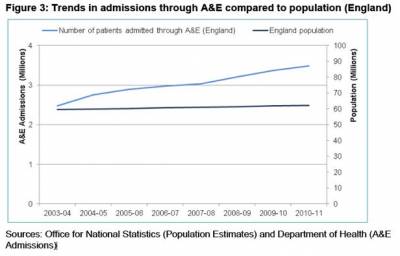111 and re-triage of A&E dispositions by GPs Featured
Andrew Anderson and Martin Roland have recently reported that experienced GPs can reduce the number of referrals from NHS 111 (Potential for advice from doctors to reduce the number of patients referred to emergency departments by NHS 111 call handlers: observational study - http://bmjopen.bmj.com/content/5/11/e009444.abstract).
It is no surprise that GPs can, when re-triaging patients after an NHS Pathways assessment by non-clinicians, arrive at very different dispositions. The typical proportion of ‘Contact GP’ dispositions that an out of hours organisation using GPs to carefully assess each call can convert to ‘telephone advice’ is over 50% for example.
But what is a surprise is the bullishness of the reports about the article in suggesting that there is a significant cost saving for commissioners. For example Pulse reporting on the paper said that “there could be a cost saving for commissioners of £11,112 if GPs were employed in the call centres, comparing savings made for A&E with GP salary costs”.
The saving of £11,112 comes from subtracting the cost of the GPs providing the triage (£41,416) from the saving in A&E attendance (£52,528). But Pulse has ignored the cost of the outcomes for those patients that are referred elsewhere than A&E (this is perhaps understandable as the original paper fails to mention them either). There are increases in referral to other services such as Minor Injury Units (using the same set of reference costs at £49/case, this is £3742) and to the OOH service for face to face consultations (at a conservative £34 per case this is £20026, but it is probably rather higher) not to mention an unknown number of cases completed over the phone but advised to contact another service or their own GP next day. However, even ignoring the latter, once these figures are added in there is no saving – the overall cost did not fall by 15%, rather it rose by at least 17%.
Of course, this is not the full story. A reduction in cost is far from the only thing that we are interested in and we may be happy to pay more to reduce the pressure on A&E and to improve the patient experience. And we don’t know other things too such as how many patients follow the advice that they were given (which the authors rightly point out would be useful to know as part of a full cost assessment) or how many of those referred to the MIU or OOH service were subsequently referred on to hospital.
And it may be that there is potential to reduce costs using GP assessment as described. This was a small scale trial, had it been carried out at scale the cost per case might have been lower. We have recently completed a model for NHS England, commissioners and providers that looks at the cost of integrated urgent care, focused particularly on NHS 111 and OOH services. Using a figure of £15 or as an indicative cost per case for phone assessment by GPs the cost for the 1474 cases would have been low enough that a modest saving might possibly have been made.
The concluding sentence in the paper says that there is a need “for further research to establish the cost-effectiveness of different approaches to triaging telephone requests for care”. I agree with this.
But the approach adopted and described in the paper is far from the only one.
Proponents of NHS Pathways would point to the importance of training call-handlers in probing when asking questions – rightly they would say that many existing 111 services have much to do in training call-handlers about how to do this - and that this would make a big difference in referrals to A&E and the Ambulance Service.
There are also opportunities to increase the proportion of clinicians directly supporting call-handlers whilst they are taking the call. Not all 111 services do this – and they certainly don’t have the number of ‘floor walkers’ to be able to give timely support to the majority of cases whenever the call-handler approaches an A&E or Ambulance disposition. To avoid delay to the despatch of an ambulance this would seem to be the right point to intervene in the process at least for Ambulance dispositions (and the cost of these dispositions is much more expensive than those to A&E) so it would seem sensible to look at the benefits of this approach.
The new commissioning standards allow commissioners and providers these sorts of freedoms (provided proper risk assessment, management and audit is included as part of the change). What is required as people experiment with different ways of working is a careful review of the impact looking at ALL of the costs and ensuring that this is reported widely so that others can learn.

